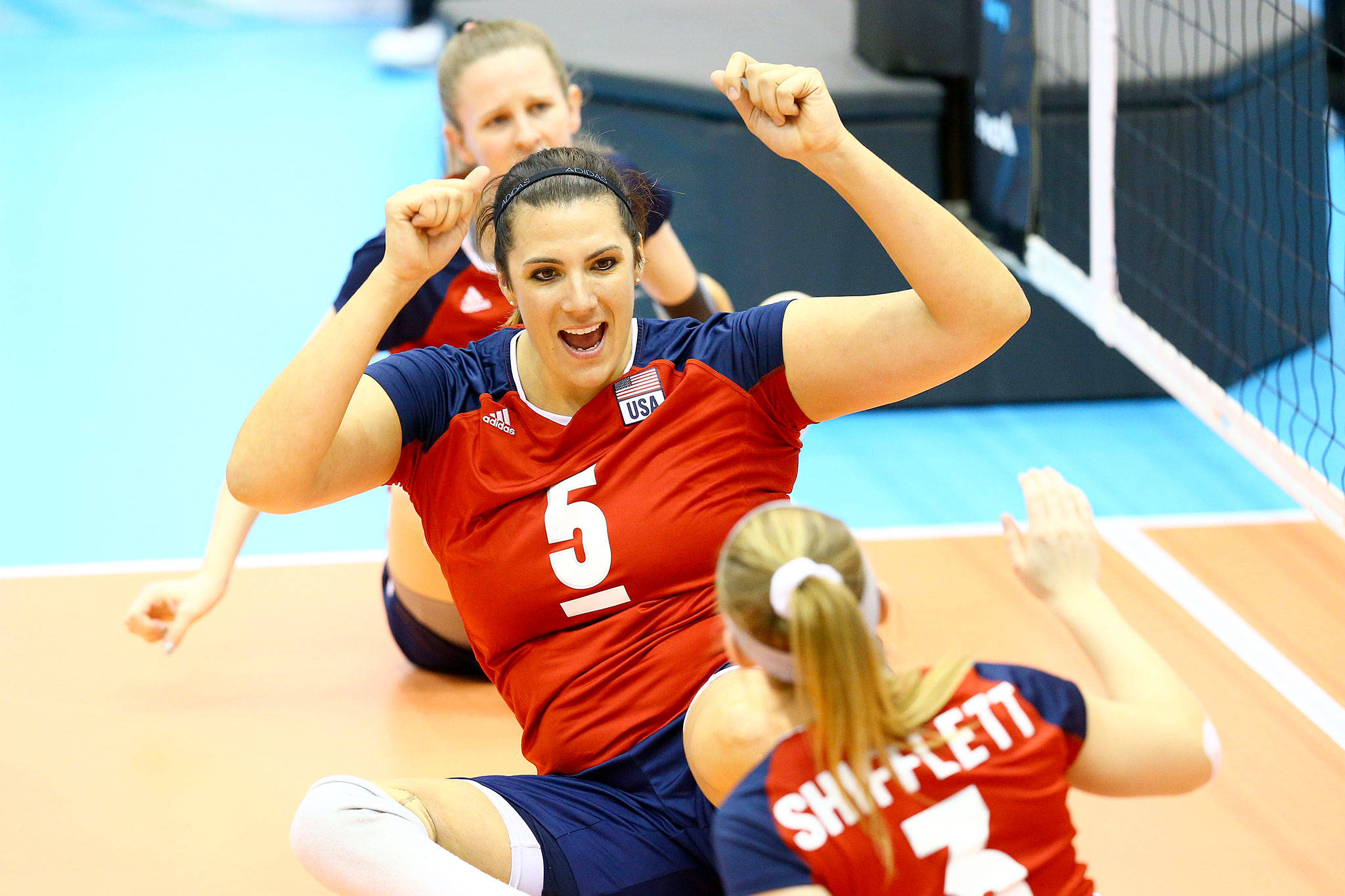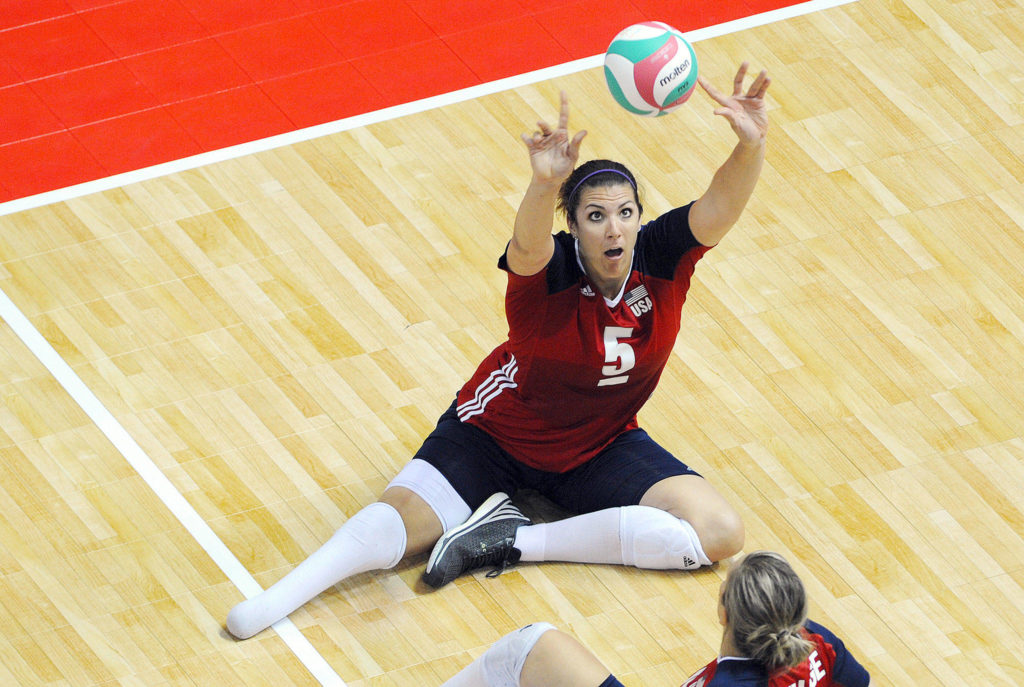Katie Holloway has become a larger-than-life figure in the United States Paralympic world.
Literally.
In late July, the 2004 Lake Stevens High School graduate, who’s been a stalwart member of the U.S. women’s sitting volleyball for 15 years, received a message from a friend that contained a photo of her visage — a story tall — hanging on the outside wall of the Adidas store in New York City.
“It’s crazy,” said Holloway, who’s been sponsored by Adidas since 2017. “Honestly, I had no idea it was there. One of my teammates from way back in 2014 was in New York and she actually took a photo and put it on Instagram into my (direct messages). She was just visiting on vacation, but I knew another volleyball guy who’s a friend of my husband who lives in New York, and we sent him to take more photos. It’s an exciting moment for everyone. I haven’t seen it myself, I’m not even sure my Adidas contacts knew it was going up.”
The towering figure is a fitting metaphor for someone who not only is about to appear in her fourth Paralympics, but who was one of the leading voices in the push by Paralympians to achieve pay equality with Olympians.
Holloway, 35, is one of the greatest players in women’s sitting volleyball history. Born with fibular hemimelia in her right leg, which resulted in her parents making the decision to amputate her foot when she was 20-months old, Holloway originally made a name for herself by becoming the first women’s basketball player in NCAA Division I history to compete with a prosthetic limb, twice being named the Big West Sixth Woman of the Year while at Cal State Northridge.
In 2006, Holloway joined the U.S. women’s sitting volleyball program, and since then the 6-foot-3 outside hitter has been showered in honors. She won silver medals at the 2008 Paralympics in Beijing (where she was the U.S.’s leading scorer) and in 2012 in London (where she was named the tournament’s Best Spiker), before the U.S. made the breakthrough to win gold over nemesis China in 2016 in Rio de Janeiro. She was named the USA Volleyball Female Sitting Athlete of the Year in 2011 and 2012, and was The Herald’s Woman of the Year in Sports in 2008.
The U.S. enters this year’s Paralympics in Tokyo, which begin Tuesday and run through Sept. 5, as the world’s top-ranked team, having not lost a match in more than two years. So expectations are high.
“Our goal is definitely to repeat as gold medalists,” said Holloway, who now lives in Palo Alto, California. “I think Russia is now our top competition. Honestly, at the end of the day it really is about making sure we take care of us and what we can do, because we know where we’re at competitively. We just need to get the job done.”
But regardless of where the U.S. finishes in the standings, Holloway has already made an unforgettable contribution not only to her team, but to all U.S. Paralympians.
In the past, U.S. Paralympic athletes received bonuses for medalling that were a fraction of what their Olympic counterparts received. According to the New York Times, the then-U.S. Olympic Committee’s (USOC) original schedule for Tokyo was for Olympians to receive $37,500 for a gold medal, $22,500 for silver and $15,000 for bronze. Meanwhile, Paralympians were to receive $7,500 for gold, $5,250 for silver and $3,750 for bronze, which is one-fifth the amount.
“It was heartbreaking to say the least, that an organization you’re a part of was not looking at you as an actual human, it was looking at you as a non-revenue generator,” Holloway said.
So in 2016, following the Rio Games, Holloway took up the fight for equality. As a member of the USOC’s Athletes’ Advisory Council, she became a vocal proponent for Paralympians receiving equal pay to Olympians. She was part of a committee of Paralympians and Olympians that examined all the financial data behind the bonuses.
After Holloway put in nearly two years of grueling effort, the USOC finally agreed in 2018 to increase the amount awarded to Paralympic medalists so that it equalled the amount awarded to Olympic medalists. Later, the USOC renamed itself the U.S. Olympic and Paralympic Committee.
“I finally felt validated in what I was saying,” Holloway said. “My fellow athletes were very supportive of what I was doing and saying, and banging the drum for a year-and-a-half was exhausting. I stepped back from a lot of roles once it was done because I couldn’t face it anymore. It was interfering with how I was competing and the joy of playing.”
It would be great to to report that Holloway is now able to concentrate fully on competing. However, Holloway was candid about the mental-health challenges associated with being an elite athlete, a subject that’s come to the forefront with the likes of tennis player Naomi Osaka and gymnast Simone Biles prioritizing mental health over competition. Holloway spoke about dealing with performance anxiety and working with a sports psychologist. The challenges are exacerbated by the uncertainties created by the coronavirus pandemic, in which one positive test means an end to one’s Paralympics.
Therefore, Holloway is approaching these Paralympics differently.
“Given all those things, I’m in the mindset to take it one day at a time and enjoy the journey,” Holloway said. “I think that when you’re later in your career these things can bog you down. So I step back and think about what matters most to me, and what matters most is my fellow teammates. My family and friends get me up in the morning, those relationships and the moments you get to share when you’re really upset or really happy and everything in between, that’s what I remember most rather than what happens on the court. That’s where I’ll place my energy, focusing on the relationships and being there for my teammates, because everything else is just volleyball. I’m still going to try and do my best, but at this point I can only focus on the present moment and trying to stay in that.”
Talk to us
> Give us your news tips.
> Send us a letter to the editor.
> More Herald contact information.


























